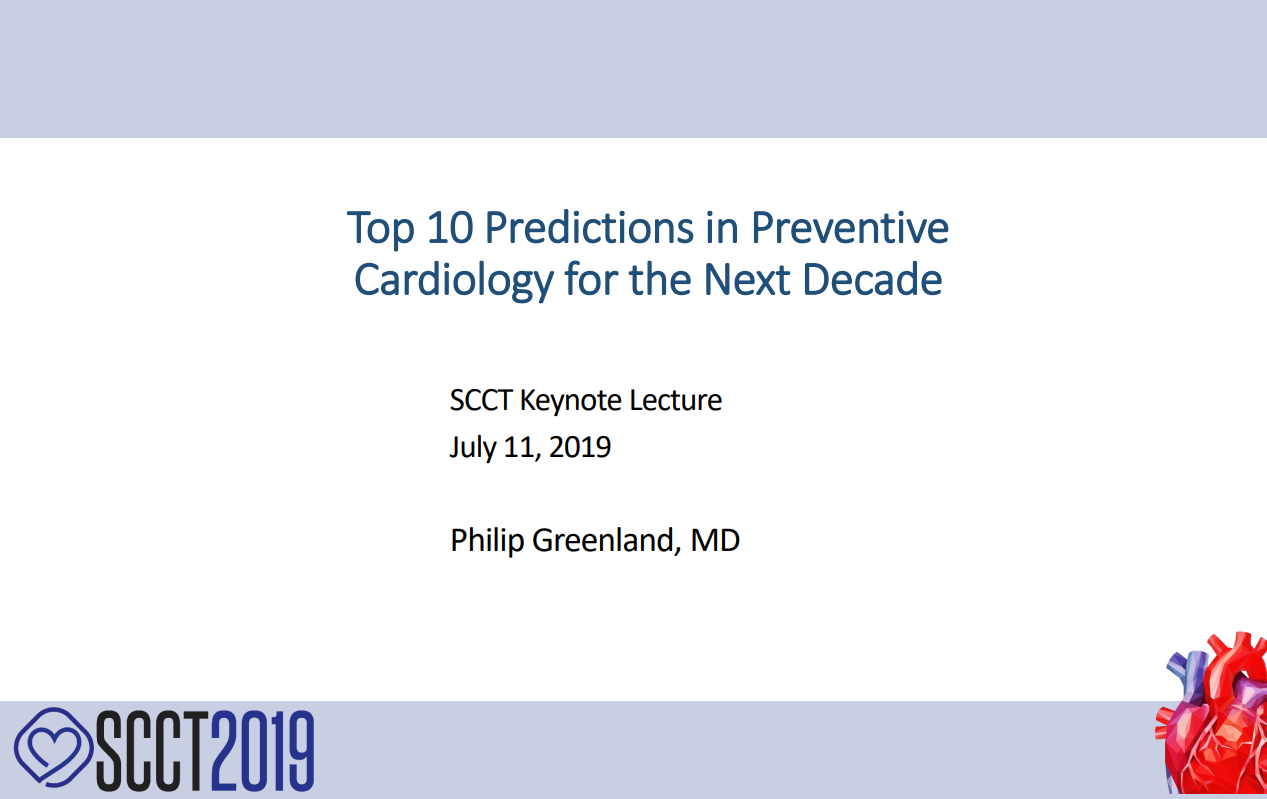Imaging, Genes, Wearables: Some Predictions for the Future of Preventive Cardiology
Many risk prediction and preventive strategies in use today will continue to grow, but gene scores and sensors? Stay tuned.

BALTIMORE, MD—The future of preventive cardiology will involve minimal use of polygenic risk scores, more use of CT, and a bigger focus on obesity reduction (including bariatric surgery), but it won’t rely heavily on sensors or wearable technology. These were some the predictions from a keynote presentation here last week at a special prevention symposium held ahead of the annual Society of Cardiovascular Computed Tomography (SCCT) meeting.
“As it has been said, it's difficult to make predictions, especially about the future,” said Philip Greenland, MD (Northwestern University's Feinberg School of Medicine, Chicago, IL), at the conclusion of his presentation looking at the field over the next decade.
Indeed, not everyone who attended this session agreed with his pronouncements, something Greenland himself had anticipated.
“My hope was that my talk would stimulate discussion and perhaps some controversy about the future,” he told TCTMD in a follow-up email. “It is worthwhile to consider where we are headed.”
Opining on ‘-Omics’
Polygenic risk scores, which have more commonly been appearing in the literature, will not be used regularly by physicians, Greenland predicted, saying: “I think they are basically not very helpful for selecting patients.” To illustrate his point, Greenland cited data from last year that was understood by many to mean that genetic risk scores are ready for clinical application. He said, however, that its C-statistic of 0.62 was “crummy,” especially compared with the performance of traditional risk factors.
“The evidence that some people . . . are using to suggest that polygenic risk scores are ready for prime time is, I think, largely overinterpreted, and I don't think it's going to be particularly commonly used. I'm not the only person who thinks that,” he said. “It's just not there yet and I don't think it's actually ever going to get there.”
Ritu Thamman, MD (University of Pittsburgh School of Medicine, PA), who attended the session, told TCTMD that she felt Greenland had been too “pessimistic” on the potential for polygenic risk scores in the future. “I do believe that [these] will be helpful, especially in the younger cohort,” she said.
But Khurram Nasir, MD (Yale University School of Medicine, New Haven, CT), who also attended the session, agreed with Greenland, telling TCTMD, “The polygenic risk score will have limited utility in risk prediction at identifying the best candidates for treatment, but at the same time, I slightly disagree that it is not going to become mainstream. It will become mainstream whether we like it or not. So rather than shunning, I would embrace it and find ways where it has the highest utility, and I think the highest utility is getting this risk score early in your [life] and . . . [changing] the trajectory by lifestyle intervention.”
Greenland, however, urged physicians to look beyond genomics to “other -omics” such as metabolomics and proteomics, which may one day be able to predict a patient’s short-term risk of MI based on a blood sample.
“One of the problems with using genetics as our only way of looking at a person’s risk is that . . . DNA is not our destiny,” he said. “Our destiny is what's actually happening as a consequence of our lifestyle and our genes.”
Obesity, Wearable Tech
Next up, Greenland had a prediction that he suspected most cardiologists would not question “because it’s already happening.” Namely, he said, rates of obesity and diabetes will continue to rise and hence lead to an increase in the prevalence of cardiovascular disease.
“It's a depressing prediction, and we all need to do whatever we can to try to reduce the rates of childhood obesity, adult obesity, and diabetes,” Greenland stressed.
On a related note, he also predicted continued growth of bariatric surgery, which has gone up from 158,000 US procedures in 2011 to 228,000 in 2017. “The real reason I think that the numbers are going to go up is because the prevalence of obesity continues to rise and the evidence for bariatric surgery as a preventive strategy is unfortunately actually very positive,” Greenland said. “It's the best treatment we have for obesity and certainly a radical approach, but given how unsuccessful we've been at preventing obesity and treating obesity by traditional means, I think bariatric surgery is going to continue to increase.”
Turning to the topic of wearable technology, Greenland predicted that more data will be gathered by consumers, but how it will be used clinically is unclear. He also sees the issues of privacy and data complexity as hindrances to their practical use.

“It's going to be really a lot of fun, I think a lot of people are going to buy these things—we already know that people are buying these things—[but] I'm just not sure that it's actually going to be useful for clinical medicine,” Greenland continued. “I get worried when every single day I pick up some news article that says that this company or government or whatever that you thought was absolutely impenetrable has been hacked, so I don't know if every patient [is] going to want to have every aspect of their life open to being hacked. And until these kinds of things are resolved, I don't think this is really going to enter clinical medicine . . . at least for the next 10 years.”
Here, Nasir said he has “the same sentiment.” While more information can be useful, “we have to figure out how to make the best use of it,” he said. However, “sensors, information from wearables will become mainstream. I agree we haven't figured it out. I think all stakeholders will have to work together.”
Thamman, likewise, predicted that privacy issues surrounding wearables ultimately will not prevent them from being used. “The electronic market is driven by all the people in the world, and that is a force that will be more impactful than us just saying this is not HIPAA-compliant. I do believe it's going to be part and parcel of our care and our practice,” she said.
CAC Will Prevail
While the search for novel biomarkers will continue, Greenland said “I don't think anything is going to beat CAC [coronary artery calcium], and the reason I think that is that I've spent the last two decades trying to beat CAC, and I haven't found anything. And I got a lot of white hair and a white beard, and it's discouraging. But CAC is actually winning again and again.”
All of the risk factors included in the Pooled Cohort Equation have been known since 1961, he noted. “Then comes along this lovely paper” which shows that the only factor that bumps down risk “a lot” is CAC.
Nasir completely agreed with this prediction. “None of the other biomarkers are going to [beat calcium] and the sole reason is because . . . atherosclerosis is very heterogeneous and no risk factor will be able to completely account for that,” he said. “It's really the presence and absence of disease, and calcium testing will become more mainstream.”
Additionally, Greenland said that the Centers for Medicare & Medicaid Services (CMS) “is going to finally cave in and grant some level of coverage for CAC.” One of the issues right now, Greenland continued, is that CMS classifies tests into one of two categories—diagnostic or screening—and “they don't see tests as anything other.” Cardiologists today, however, view CAC as primarily a tool for risk assessment and the impact of using it needs to be strongly conveyed to CMS.
“What's going to make this happen is if all of us get together and say . . . [in fact] what coronary calcium does is that it diagnoses the disease that we care about, which is atherosclerosis. That's what we need to convince CMS of, that it diagnoses a disease that kills people,” he said.
CTA, Cross-training, E-cigarettes
For his final predictions, Greenland predicted that CT angiography (CTA) is going to become the test of choice for the evaluation of possible cardiac chest pain. He referenced the fact that the NICE guidelines in the United Kingdom have already made CTA a first-line test.
He also believes that, increasingly, cardiologists will need “cross-training” in other diseases, especially diabetes, and he also predicted minimal if any use of anti-inflammatory drugs to treat residual risk. “I think it's interesting from a scientific point of view, but from a practical point of view, nah. No one's going to do it,” he said.
Adding one more prediction to the list, Michael J. Blaha, MD, MPH (Johns Hopkins Ciccarone Center for the Prevention of Cardiovascular Disease, Baltimore, MD), said he’s concerned about the rise in e-cigarette use. “I can't sit here and tell you right now that they cause cardiovascular harm, although we're working on that topic, but the proliferation of these, especially among young people, is tremendous,” he said in a discussion following Greenland’s presentation.
“I agree with you,” Greenland replied. “It's incredibly shocking what's happening with electronic cigarettes and the growth of it, and I suspect the only way it's going to stop is if the FDA comes along and says you have to be 25 . . . to purchase.”
Yael L. Maxwell is Senior Medical Journalist for TCTMD and Section Editor of TCTMD's Fellows Forum. She served as the inaugural…
Read Full BioSources
Greenland P. Top 10 predictions in preventive cardiology for the next decade. Presented at: SCCT 2019. Baltimore, MD. July 11, 2019.
Disclosures
- Greenland reports receiving grants from the American Heart Association and the National Institutes of Health.
- Blaha reports receiving grants/research support from the Amgen Foundation and the Aetna Foundation and serving as a consultant to the Amgen Foundation, Novo Nordisk, Novartis, and Medicure.
- Thamman and Nasir report no relevant conflicts of interest.


Comments